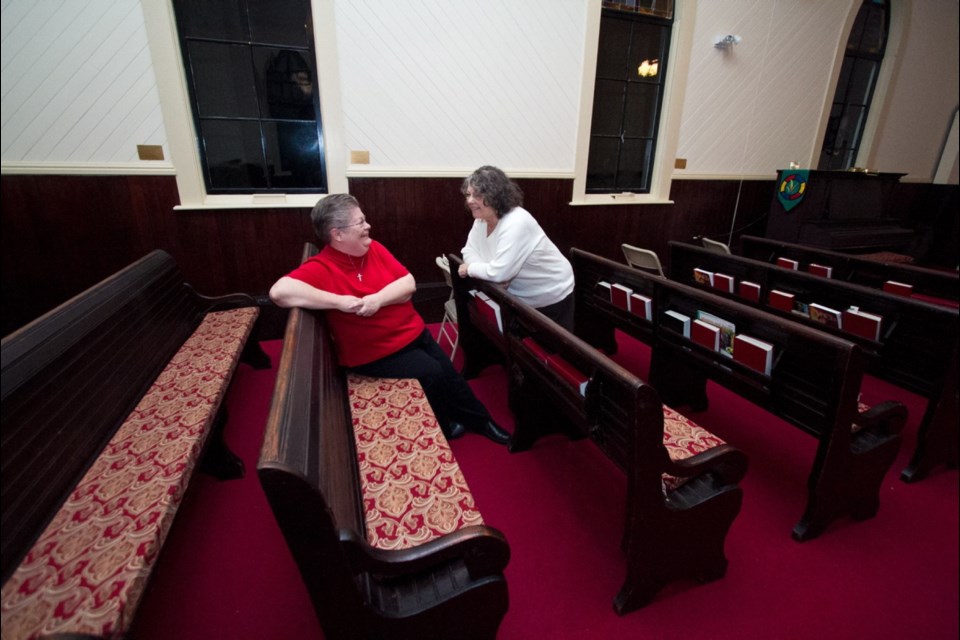Tough on the bum but tender to the soul, antique pews at Shady Creek United Church in Central Saanich still seat parishioners, making services there a living legacy of Afro-Canadian pioneers.
Black History Month, with special lectures, tours and events, runs throughout February. But perhaps nowhere else on southern Vancouver Island is the sense of black history and accomplishment felt so keenly as Shady Creek United Church and its pews.
The pews were built by free-born Afro-American carpenter Charles Alexander, who arrived with his wife Nancy in the 1850s. The couple took up the 1858 invitation from Sir James Douglas, then governor of B.C., himself half-Creole, who had implored blacks in California to settle on Vancouver Island.
Karen Hoshal, great-granddaughter of Alexander, still attends services at Shady Creek Church, 7176 E. Saanich Rd., where she feels like she is with “family.”
Small cushions are now spread on the pews, although everyone is pretty sure Alexander, himself a lay preacher, would not have approved.
“He was heard to say, ‘The pews are not built for comfort, they are built so you will sit up straight to hear the word of the Lord,’ ” Hoshal said.
“I can just envision him saying that,” she said. “The stories say he had a loud, booming voice so everybody would have heard.”
Ron Nicholson of Victoria, vice-president of the B.C. Black History Awareness Society, said the historical accomplishments, passages and stories of blacks in Canada are all over the country, but often overlooked.
“There are still a lot of people who are not really aware that black people have been here in Canada in most areas going back to the earliest days,” Nicholson said.
For example, records show blacks landing in Nova Scotia as early as 1628. This was later followed by substantial numbers arriving from the Caribbean colonies. Southern Ontario was the end terminus of what was nicknamed the Underground Railway in the years leading up to the U.S. Civil War. This trek, guided by heroic “conductors,” such as ex-slave Harriet Tubman (1820-1913) brought runaway slaves to freedom from the southern U.S.
Nicholson, originally from St. Catharines, Ont., traces his ancestry back to a great-grandfather who came to Canada to escape slavery.
And in Western Canada, entire towns, including Maidstone, Sask., and Wildwood, Alta., (originally Junkins) were founded by black families on what were called block settlements. These were a form of land distribution provided by the federal government to allow settlers with the same ethnicity to form small colonies.
Nicholson said black settlers were often forced to accept land of questionable quality. They were also, in some cases, subjected to tests and even discouraged by stories they would not withstand Prairie winters.
But they still came, settled, worked and stayed.
“There are a lot of people in those areas that did stay, remained, worked and have been citizens ever since,” Nicholson said. “But there are still a lot of people who think blacks arrived in Canada only recently.”
At Shady Creek United Church, about 60 parishioners gather every Sunday united by Christian faith and also by the unique history of their building.
Rev. Jonelle McLellan, who has been with Shady Creek about 21Ú2 years, said stories of the pews and their connection with a special piece of Canadian history make for a special atmosphere.
None of the congregation is obviously black. Even Hoshal agrees most people don’t take her for black at first glance. But that doesn’t stop Shady Creek parishioners embracing their past.
“The congregation has a real strong sense of its own history,” McLellan said. “It ties them together more than it does with congregations where the physical evidence of the history of the building is perhaps not quite so evident.
“It gives a strong sense of continuity with all the saints who go back eons when you worship in a church with a history like that.”
McLellan said some of the history of the building remains somewhat mysterious.
The congregation was established 150 years ago, but McLellan said the original church location is unknown but was possibly near Sandhill Creek, leading to its name. That church burned down.
“But by some stroke of good fortune, those pews got spared,” she said.
The existing church was finished in 1895 and Alexander’s original, no-nonsense pews were installed.
McLellan said all United churches across Canada take note of Black History Month. But at Shady Creek, parishioners take it a little more seriously. “It feels more important to them than most other congregations,” she said.
For more information and event details, go to the Black History Awareness Society website at islandnet.com/~bcbhas/ or the Greater Victoria Public Library at gvpl.ca



